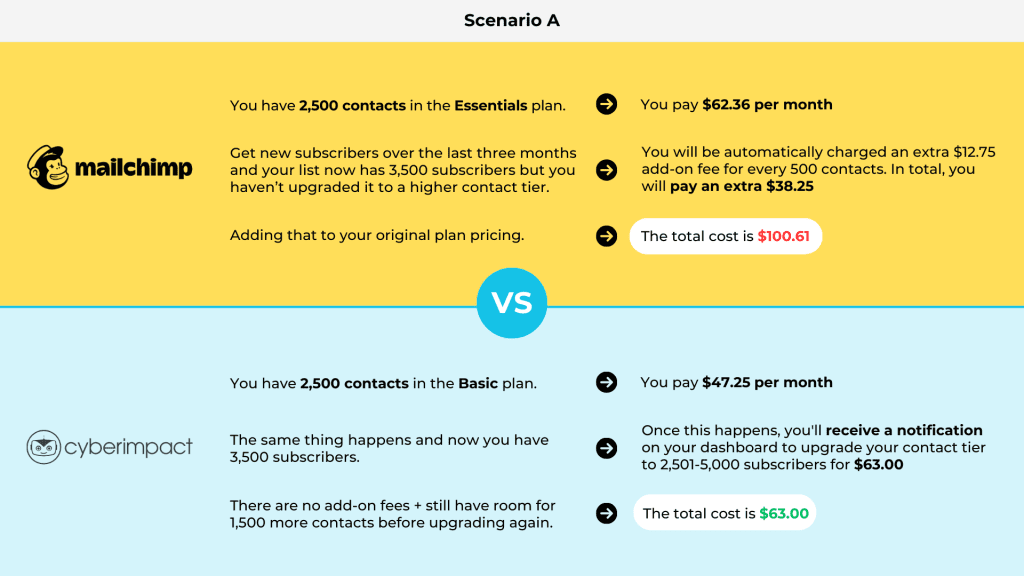All information was collected on July 30, 2025.
Looking for the latest on Mailchimp’s pricing to plan your email marketing budget? As one of the most used email marketing platforms in the market, Mailchimp sparks a lot of interest—and questions regarding its pricing system.
This transparent Mailchimp Pricing Guide gives you everything you need to know before making a decision. Learn how their pricing system works, plus the crucial details most marketers miss.
Finally, you will find a quick comparison with Cyberimpact, a leading Canadian Mailchimp alternative.
What Is Mailchimp? Why Is Mailchimp’s Pricing So Talked-About?
Mailchimp is one of the most popular email marketing platforms out there. However, as it has grown, its pricing structure has become more complex—with important feature restrictions and hidden costs marketers often overlook.
To help you follow along, let’s use Sarah as an example: When Sarah launched her clothing shop in Toronto, she turned to email marketing to build relationships and grow her sales.
Like many Canadian small business owners, Sarah was drawn to Mailchimp for its well-known name—and its promise of starting for free.
However, as her subscriber list grew, she realized that understanding Mailchimp pricing wasn’t so simple: Costs went up fast, and certain features she needed were locked behind paywalls or higher tiers.
Key Mailchimp Pricing Considerations & Gotchas
1. You’re charged for every contact—even unsubscribed and duplicates.
Mailchimp defines a contact as “an individual member of your audience.” And explains on their website that “subscribed, unsubscribed, and non-subscribed contacts are included in your contact count.”
This means you’ll quickly hit limits unless you frequently “clean” your list. Also, if a contact is present in more than one group, or “audiences”, it will count as two contacts—this can get on the way of running segmentation campaigns.
2. Price escalates rapidly as your list grows.
Growing companies might miss the timing to update their plans to a higher contact tier, thus driving up costs. Let’s look at Sarah’s example again: If she signups up for the Standard Plan with 2,500 contacts it’ll cost about $83/month. As her business grows, so does the email list. Having 5,000 contacts on the same plan would over $138/month (+66%).
However, due to her busy schedule, Sarah hasn’t had the chance to update her contact tier. She now has about 5,000 contacts—counting subscribers, unsubscriptions and non-subscribed contacts.
This means she will have to pay additional charges for add-on contact blocks. Each block of 300 contacts cost $12.50. She will need 9 contact blocks (2,700 contacts) to cover the difference, adding $112.50 to her bill. Her monthly email cost will then be around $195/month (+134%).

3. Features are “gated” by plan.
Multi-step automations, detailed analytics, and advanced segmentation are not available on the free or Essentials plans.
4. Extra services mean extra charges.
The starting prices include email marketing only. If you want access SMS messaging, transactional emails, or advanced user roles, that’ll cost you extra.
5. Support is limited unless you pay for Premium.
Despite customer support being available on all paying tiers, only the high-paying customers get phone support, making it harder to deal with urgent issues.
Mailchimp Pricing Guide: Plans & Features
Mailchimp offers four plans: Free, Essentials, Standard, and Premium. Each plan increases in price and features depending on the size of your contact list and business needs.
1. Free Plan (up to 500 contacts)
Who it’s for: Beginners or micro-businesses testing email marketing.
- Contacts: Up to 500 (counting active, unsubscribed, and duplicate contacts)
- Monthly email sending limit: 1,000 (capped at 500/day)
- Users: 1
- Lists/Audiences: 1
- Features: Basic email templates, one-step automations (e.g., single welcome email), signup forms, basic analytics, Mailchimp branding on every email
- Support: Email-only for first 30 days
Key limitations:
- You pay for unsubscribed and duplicate contacts as part of your limit
- No multi-step automations, no A/B testing, no scheduling
- No advanced analytics, transactional emails, or custom branding
- Most businesses will outgrow this tier quickly
2. Essentials Plan
Who it’s for: Small teams needing more emails, templates, and basic automations
- Price: Starts at $13/month (500 contacts; increases with list size)
- Monthly email sending limit: 10x your contact allowance per month (e.g., 5,000 for 500 contacts)
- Users: 3
- Audiences: 3
- Features: Unlocks more template designs, A/B testing, email scheduling, basic segmentation, and landing pages
- Support: 24/7 email and live chat
3. Standard Plan
Who it’s for: Growing businesses wanting advanced automations and reporting
- Price: Starts at $20/month (500 contacts; scales fast with list size)
- Monthly email sending limit: 12x contact cap/month
- Users: 5
- Audiences: 5
- Features: Multi-step customer journeys, advanced behavioural targeting, predictive analytics, dynamic content, comparative reporting
- Support: 24/7 email and chat, plus personalized onboarding on higher tiers
4. Premium Plan
Who it’s for: Enterprises with large lists and multiple teams
- Price: Starts at $350/month (for 10,000 contacts)
- Monthly email sending limit: 150,000+ monthly (15x contact cap)
- Users: Unlimited
- Audiences: Unlimited
- Features: Full segmentation, multivariate testing, role management, advanced analytics, priority phone support, and onboarding
Cyberimpact vs Mailchimp: The Best Mailchimp Alternative for 2025
Cyberimpact is the go-to email marketing alternative for businesses—especially those that value data privacy and need simple but robust free plans. Whereas Mailchimp’s free tier now feels restrictive and costly for businesses, Cyberimpact offers a more functional and scalable free plan, particularly for those in Canada or with privacy concerns.
Unlike Mailchimp, Cyberimpact offers more contact tiers—what keeps growing businesses from overspending—, and only subscribed contacts are counted in the plan tier.
Cyberimpact Free Plan Advantages
- Up to 250 contacts
- Unlimited sends and unlimited users.
- Full Compliance with GDPR, CAN-SPAM, CASL, including built-in consent tools (ideal for Canadian businesses or business that have Canadian clients)
- No credit card required
- Bilingual support (English/French) via phone, email and chat
- Access to advanced segmentation tools
Which Email Marketing Service is Best for Your Business?
Mailchimp remains a popular choise with its modern interface and powerful options—if you’re ready to budget for rapid price increases and keep your lists meticulously clean. Nevertheless, its pricing model has become restrictive for growing small businesses and startups, especially compared to newer options like Cyberimpact.
Canadian businesses seeking a transparent, fully-featured email marketing platform that doesn’t have unexpected costs, Cyberimpact emerges as a compelling alternative.
Before you settle on Mailchimp, use this Mailchimp pricing guide to project your future costs and needs. To become stress-free when it comes to compliance, get quality customer support, and pricing predictability, looking local can pay off.
